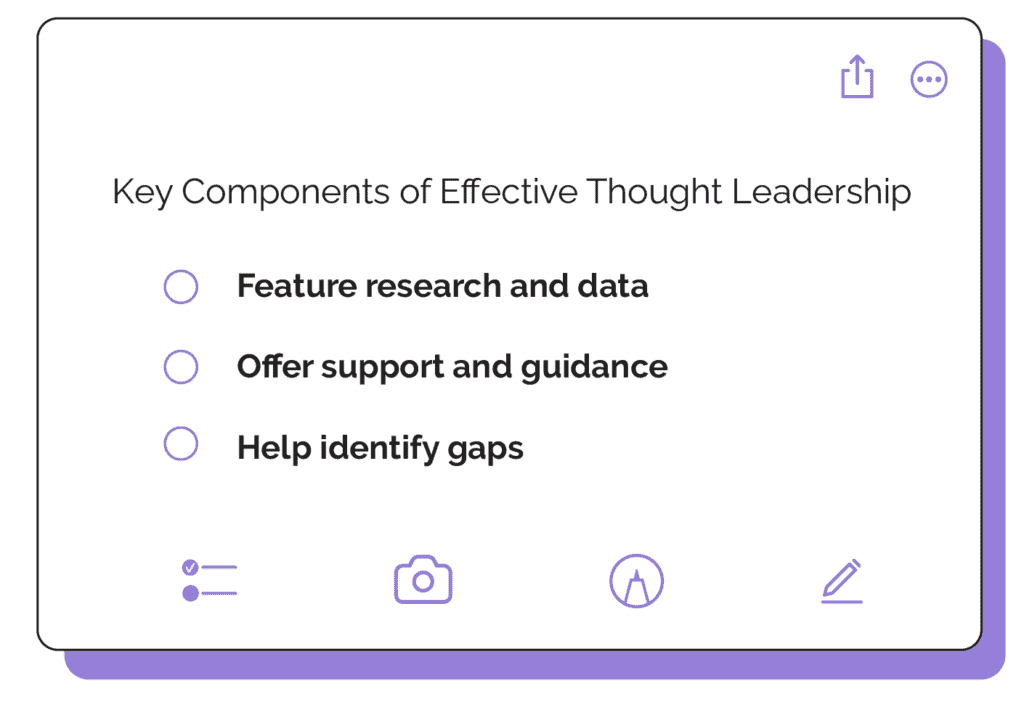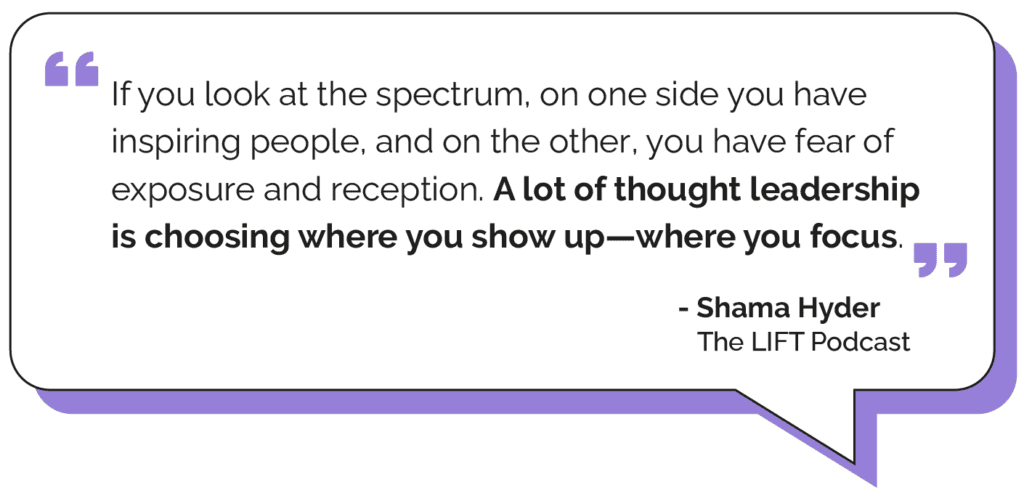Let’s address the elephant in the B2B marketing room…

A staggering 95% of potential business clients aren’t actively searching for your product or service right now.
It’s a daunting statistic, especially when coupled with the reality of longer sales cycles and buyers’ increasing preference for self-directed research. In this landscape, it becomes crucial to not only capture their attention but also keep it.
What’s the best way to accomplish that? Enter B2B thought leadership—the not-so-secret weapon that can turn the tide in your favor.
What Is Thought Leadership?
Thought leadership is a strategic approach to content marketing that positions individuals or organizations as experts in their industry.
It goes beyond just promoting products or services and instead focuses on providing valuable insights, knowledge, and perspectives to your target audience. Thought leaders are considered trusted advisors and go-to sources of information, making them influential figures in their respective fields.
However, thought leadership is about more than just being an industry authority. It’s about leveraging your knowledge and expertise to establish yourself or your company as a trusted and respected source. By becoming a thought leader, you not only increase brand awareness and enhance brand recognition but also instill a sense of security and confidence in your audience. Ultimately, this strategy can drive more leads and revenue to your business.
The Power of Thought Leadership
54% of C-level executives spend over an hour a week engaging with thought leadership. The same is true for 52% of management-level professionals across the globe.
Simply put, the people making decisions—the individuals you want to be familiar with your brand—actively consume thought leadership content. And yet, many B2B brands are still failing to capitalize on it fully.
Why the hesitation? Measurement challenges. Because of the way it is shared and tends to spread, thought leadership isn’t as easily trackable as some other marketing initiatives.
Related Reading: The Ultimate Guide to Thought Leadership
We say it all the time here at Zen, but most people consume content publicly and share it privately. This style of endorsement may go unknown to you directly, as its impact is not made immediately obvious through common metrics and engagement statistics, such as likes and comments.
Don’t be misled by an absence of comments or likes; thought leadership still greatly impacts your business, even if it is not directly measurable. When someone shares your content, the exposure and trust you earn both powerful tools for your business efforts.
But the benefits of thought leadership don’t end there:
It builds trust.
Trust is the foundation of any successful business relationship. When someone trusts your brand, they are more likely to choose it over competitors, become a repeat customer, and recommend your products or services to colleagues and friends (the all-important word-of-mouth marketing!).
More importantly, 73% of business decision-makers trust thought leadership content more than any other marketing materials.
When you become an established thought leader in your industry, you and your brand earn the trust and respect of your target market. This is a natural result of positioning yourself as a reliable and educated voice on relevant industry issues and trends.
Thought leaders are seen as experts in their field, possessing deep knowledge and insights that others don’t have. So, by consistently producing high-quality, valuable content, you establish your brand as a reliable source of information for existing customers and new prospects seeking guidance and expertise.
The key takeaway? Customers who trust your brand are more likely to engage with your content, consider your offerings, and ultimately move through the sales funnel.
It legitimizes your company.
90% of decision-makers are more receptive to sales outreach from companies producing consistent, high-quality thought leadership.

And it’s obvious why. People are more likely to listen to someone (and later, be sold on a product or service) when they believe that person is a respected and well-established source.
Related Reading: Why Your C-Suite Should Be Thought Leaders
By sharing your expertise, you gain recognition in the industry. That increased visibility helps to differentiate your brand from competitors and instills confidence in your audience. It can also attract top talent to your organization, as professionals are always looking to work with companies positioned at the forefront of their industries.
In showcasing your thought leadership, you can draw in skilled individuals who want to join your innovative and forward-thinking team (and who wouldn’t want that?!).
It shows your customers what you stand for.
But high-quality thought leadership does so much more than simply make your brand look good to consumers.
By sharing thought leadership content, you can help your customers gain a deeper understanding of your company’s values, beliefs, and expertise. This will give customers a better sense of what you stand for as a brand while establishing an emotional connection.
Customers are not always just looking for products or services; they often want to align themselves with brands that share their values and exhibit thought leadership in their respective industries. You can demonstrate your commitment to staying ahead of the curve and solving industry challenges by consistently sharing valuable insights and innovative ideas.
Related Reading: Is Thought Leadership PR?
It boosts customer retention.
Along with showing customers who you are, thought leadership can also help you retain your existing customers. By providing valuable insights and thought-provoking content, you create a sense of loyalty and trust among your audience. They see you as a reliable source of information and are more likely to continue doing business with you.
Thought leadership also helps to build relationships with customers. You can engage with your audience, answer their questions, and address their pain points through your content. This two-way communication fosters a sense of community and strengthens the bond between your brand and your customers.
Related Reading: 6 Ways To Gain Credibility as an Industry Thought Leader
It provides exposure.
75% of decision-makers explored a product or service they weren’t previously considering because of an encounter with relevant thought leadership content.
By consistently producing thought-provoking and insightful content, you can attract potential customers who are actively seeking information or solutions in your industry. Thought leadership helps you (and your brand) become a go-to resource and increase your visibility to potential customers, which creates familiarity and trust with your target audience.
By leveraging various outlets such as social media posts, guest blogging, awareness campaigns, and speaking engagements, you can amplify the reach of your thought leadership content. As more people are exposed to your brand and recognize your expertise, your brand recognition grows.
Related Reading: Finding the Right Platform for Your Thought Leadership
It attracts top talent.
As mentioned earlier, thought leadership can help attract top talent to your organization. When prospective employees see you or your brand as respected and well-known in the industry, they are more likely to be drawn to opportunities to work with you.
By consistently sharing valuable insights and showcasing your expertise, you demonstrate to potential employees that your organization is forward-thinking, innovative, and at the forefront of industry trends. This can be a strong selling point when recruiting and hiring top talent.
Related Reading: How to Attract Top Talent and Increase Employee Retention
Key Components of Effective Thought Leadership

Now that you know why thought leadership is so great, it’s important to know what separates good (or even average) thought leadership content from the best of the best.
While thought leadership may seem like a buzzword, it holds significant value in building brand awareness and recognition. Establishing thought leadership is crucial for B2B companies to differentiate themselves and gain a competitive edge.
Related Reading: Half of B2B Thought Leadership Isn’t Valuable. Here’s Why.
A strong thought leadership piece should do the following:
Feature research and data
One important element of an effective thought leadership strategy is featuring research in your content. Data adds credibility to your insights. When you support your ideas and perspectives with solid information, you provide valuable evidence to support your claims, which differentiates you from those who may simply be sharing opinions.
Including relevant statistics, case studies, and industry trends in your thought leadership content helps strengthen your argument while demonstrating that you have done your homework. This appeals not only to your target audience but also to other industry professionals, making them more likely to view and share your content. As a result, your brand’s visibility and authority will increase.
Offer support and guidance
Another essential element of a successful thought leadership strategy is to offer support and guidance to your audience. People are looking for solutions and actionable advice from thought leaders, so it’s important to provide them with practical tips and suggestions they can implement in their lives or businesses.
By offering tangible value to your audience, you position your brand as a trusted resource and build a loyal following. This could include sharing best practices, step-by-step guides, or even hosting webinars or workshops where you can dive deeper into the topics you are knowledgeable about. When your audience sees that you genuinely want to help them succeed, they will be more likely to engage with your content and share it with others.
Help identify gaps
One of the main goals of thought leadership is to help identify gaps or challenges within your industry and provide innovative solutions. By understanding your target audience’s needs and pain points, you can address these issues head-on and offer unique insights and perspectives.
Being a thought leader means that you are not afraid to challenge the status quo and think outside the box. You can provide fresh ideas, alternative approaches, and new perspectives that others may have yet to consider. This strategy positions you and your brand as a forward-thinking and industry-leading authority.
Common Myths About Thought Leadership
While thought leadership is becoming increasingly well-known, it is often misunderstood. Here are some of the most common misconceptions we see with our clients and across the industry:
Related Reading: 5 Marketing Myths That Are Harming Your Organization
Myth #1: “It’s only relevant for B2B companies.”
While thought leadership is often associated with B2B companies, it is a strategy that can benefit businesses of all types and sizes. Any brand that wants to establish itself as an authority in its industry can leverage thought leadership to build trust, credibility, and recognition.
Thought leadership is not limited to B2B companies because it is fundamentally about providing valuable insights, knowledge, and expertise. Whether you are a B2B company targeting other businesses or a B2C company catering to consumers, becoming a thought leader can help you connect with your target audience on a deeper level.
For B2C companies, thought leadership can enhance brand reputation and foster customer loyalty. By sharing valuable content that educates and enriches the lives of your audience, you can build a community of loyal customers who see your brand as an authority.
Myth #2: “It has to be serious.”
Many people have the misconception that thought leadership content has to be serious and academic in nature. While it is true that thought leadership often involves in-depth insights and analysis, it doesn’t mean that it has to be dry, boring, or inaccessible.
In fact, incorporating elements of storytelling, humor, and personal anecdotes can make your thought leadership content more engaging and relatable. Remember, your goal is to connect with your audience and inspire them to think differently. Injecting your personality and infusing emotional appeal into your content can be much more effective than simply throwing out facts.
Of course, authenticity can be scary! We get it. Our best advice? Take it from our powerhouse CEO, Shama Hyder:
“If you look at the spectrum, on one side you have inspiring people, and on the other, you have fear of exposure and reception. A lot of thought leadership is choosing where you show up—where you focus.” — The LIFT Podcast

Related Reading: 7 Unusual Ways to Look at Personal Branding
Myth #3: “Expertise is all you need.”
Expertise is, of course, a crucial component of solid and effective thought leadership.
But to become a thought leader, expertise alone is not enough to truly stand out and make an impact. At Zen, we’ve found that the best thought leadership strategies can be broken down into three parts: trust, relevance, and amplification.
Trust
This one goes hand-in-hand with expertise. You can only be a thought leader by earning your audience’s trust, which comes from both industry knowledge and vulnerability. While having the answers to important questions will help legitimize your company, authenticity—sharing your highs AND your lows—is what will earn trust.
Relevance
People want to hear from you! And this doesn’t always have to be directly related to your industry. While trying to weave your comments and content back to your area of expertise is helpful, adding your voice to a different conversation you have relevant experience with or information about can be just as impactful. This strategy can help you build your following and expand your reach to a wider audience.
Amplification
You have to share your message! Promote your content across all your social media platforms, and encourage your connections (and even employees of your business) to promote it. Visibility is one of the most important aspects of any successful marketing effort. Whether it is a blog post, social media campaign, awareness campaign, thought leadership piece, or any other marketing campaign, you must amplify your content across all social media channels to establish strong brand awareness and a solid social media presence.
Let’s Chat
Those who continue to prioritize mere measurability over meaningful impact will continue to miss out on golden opportunities. Don’t be the brand that makes this mistake. Embrace thought leadership, not just as a marketing strategy, but as a philosophy that builds trust, drives engagement, and ultimately propels business success.
Need some help? Ask the experts. Our team here at Zen is happy to help you develop thought leadership, amplification strategies, and a comprehensive content marketing strategy for your business.




